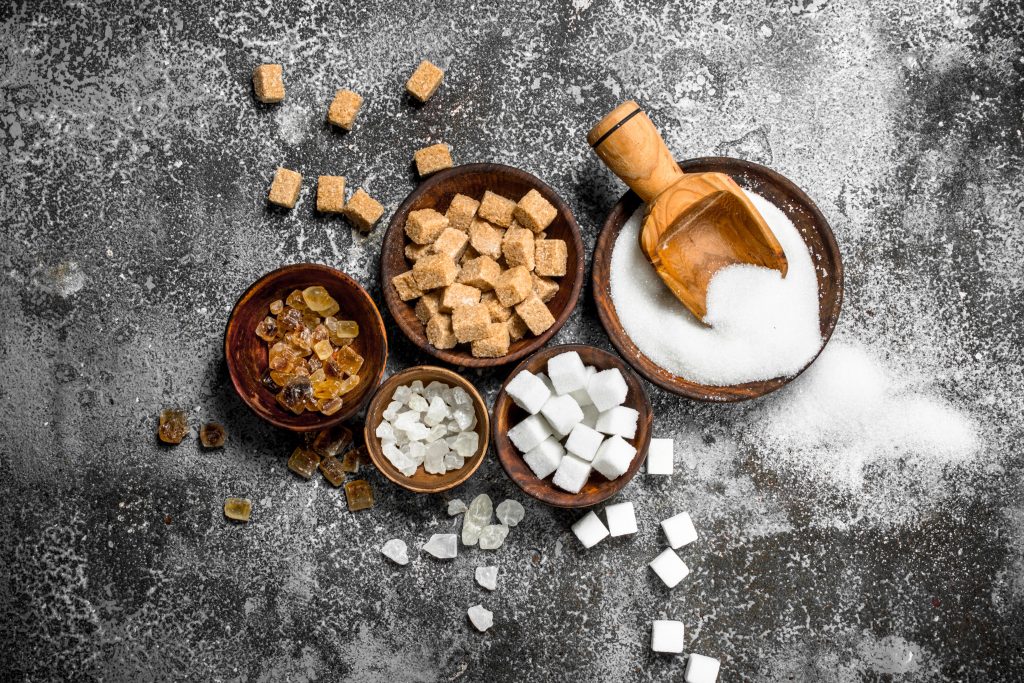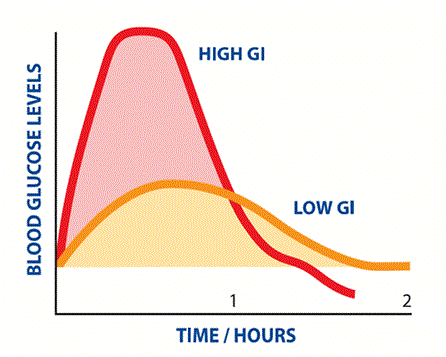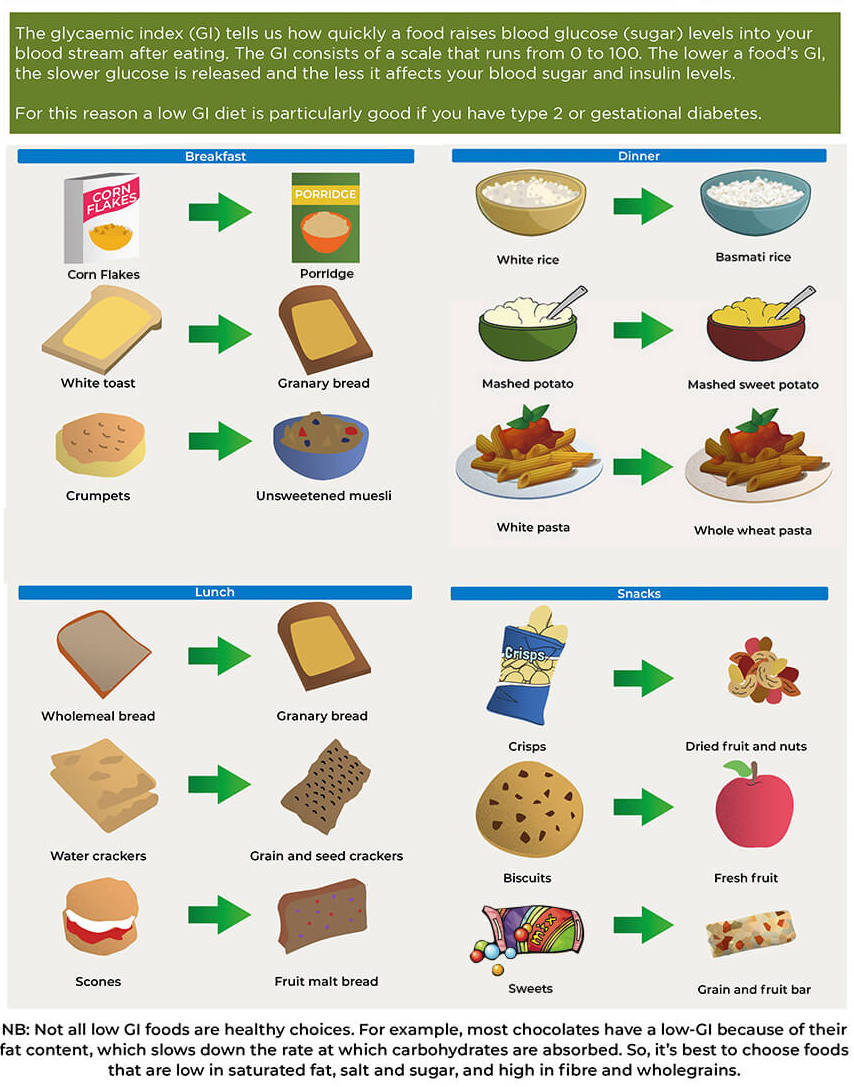Carbohydrates – 2

Nutrition Info
Glycemic Index
Glycemic Index (GI) is a way to measure how quickly the carbohydrates in a food can raise our blood sugar levels. It gives us an idea of how different foods affect our bodies. Here's a simple explanation:
When we eat foods that contain carbohydrates, like bread or pasta, they are broken down into sugar in our bodies. Some foods break down quickly, causing our blood sugar to rise faster, while others break down more slowly, causing a slower rise in blood sugar.
The Glycemic Index ranks foods on a scale from 1 to 100 based on how quickly they raise blood sugar levels. Foods with a high GI (closer to 100) cause a faster rise in blood sugar, while foods with a low GI (closer to 1) cause a slower rise.
Choosing foods with a lower GI can help us maintain more stable blood sugar levels throughout the day. These foods are usually healthier because they are often rich in fibre and nutrients.
The Glycemic Index (GI) of a food affects us in these ways:
-
Blood sugar: High GI foods raise blood sugar quickly, while low GI foods cause a slower rise. Stable blood sugar is important for overall health.
-
Energy: High GI foods give a quick energy boost but can lead to crashes. Low GI foods provide sustained energy.
-
Hunger: High GI foods may leave you hungry soon after eating. Low GI foods keep you fuller for longer.
Weight management: Low GI foods, often high in fibre, help control appetite and support weight management.
To compare different foods, they are tested using a serving size that contains 50 grams of carbohydrates. This serving size can vary a lot, from 3 tablespoons of honey to 3.5 cups of cooked carrots.
Here are the GI categories:
- Low GI: 55 or less. These foods are often legumes, vegetables, and milk products.
- Medium GI: 56-69. These foods are usually whole grains and fruits.
- High GI: 70 or more. These foods are often processed foods made with refined flour.
Understanding the GI can help us choose foods that have a slower impact on our blood sugar levels and provide more sustained energy.

Glycemic Load
Glycemic Load (GL) is a measure that tells us how much a specific amount of food will affect our blood sugar levels. It takes into account both the quality (GI) and quantity of carbohydrates in a serving of food.
Here's a simplified explanation:
Imagine you have two foods with the same GI, like a small apple and a large apple. The small apple has fewer carbohydrates, so it will have a lower impact on blood sugar. The large apple has more carbohydrates, so it will have a higher impact on blood sugar.
Glycemic Load considers the portion size of a food and gives us a more accurate understanding of how it affects our blood sugar. It's like looking at the whole picture instead of just one piece.
A low GL means the food has a smaller impact on blood sugar, while a high GL means it has a larger impact. Choosing foods with a lower GL can help maintain stable blood sugar levels and promote better overall health.
Added Sugars
When it comes to sugar, it's best to use as little as possible, regardless of the type. The NHS recommends that added sugars should make up no more than 5% of our daily calorie intake. For those aged 11 and over, this is about 30g of sugar per day.
Here are some common sweeteners:
- White sugar: It comes from the sugar beet or sugar cane plant.
- Molasses: It is a by-product of white sugar production and can be added to make brown sugar. It contains trace minerals like iron.
- Agave syrup: It is processed at a low temperature and is used by raw food enthusiasts. It has a higher fructose content than high-fructose corn syrup, which can be harmful in excess.
- Stevia: It is a calorie-free sweetener that is about 200 times sweeter than white sugar. It was authorised for sale in the UK in 2011.
- Maple syrup and honey: These have unique flavours and contain trace minerals. However, the mineral levels are low and should not be relied on for significant nutritional value. Raw honey is suitable for raw food diets but should be avoided during pregnancy. Children under one year old should not consume honey due to the risk of botulism.
- Birch syrup and brown rice: These are lesser-known sweeteners found in specialty shops.
Here are some recommendations for healthier sweetening options:
- Use real fruit to sweeten dishes whenever possible. Ripe bananas, applesauce, or pumpkin puree can be used in baking, and dried or fresh fruit can be added to cereal and yogurt. Fruits contain added fiber, which helps slow down the release of sugar into the body. Buying local fruits supports the economy and reduces transportation emissions. Fruits also provide a variety of vitamins and minerals and contribute to your daily recommended intake.
- Try using spices like cinnamon and nutmeg as alternatives to sweeteners. Dark chocolate, unsweetened coconut shavings, roasted nuts, fresh mint, and naturally sweet teas like Rooibos can also be suitable alternatives to added sugars.
Free Sugars
Hormones and hormone-like proteins
Hormones and hormone-like proteins are substances in our body that act as messengers to regulate various functions. They help control processes like blood sugar levels, appetite, and mood. Here are some key points:
Insulin & Glucagon (regulate blood sugar levels):
- Insulin helps glucose (sugar) enter our cells, providing them with energy. It is released when we eat carbs.
- Glucagon raises blood sugar levels when they drop between meals by releasing stored glucose from the liver.
Leptin and Ghrelin (regulate appetite):
- Leptin tells us when we're full and suppresses appetite. It is released from our fat stores or stomach lining in response to food.
- Ghrelin stimulates appetite and is released by the stomach cells when we feel hungry.
Carbohydrates and Mood:
- Carbohydrates play a role in our mood because they can increase the production of serotonin, a chemical that improves mood.
- Low-carb diets may affect mood negatively, as they reduce serotonin production.
Carbohydrates and Diabetes:
- In type 2 diabetes, the body has trouble using insulin or doesn't produce enough of it. Carbohydrate intake needs to be managed carefully.
- Consistent carbohydrate consumption helps maintain stable blood sugar levels throughout the day.
- Snacks with carbohydrates and protein can help stabilise blood sugar. High-fibre carbs and combining them with protein and fat slow down digestion.
- Some individuals with diabetes may require insulin injections to help control blood sugar effectively.
